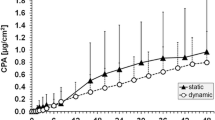Abstract
N-Phenyl-2-naphthylamine (P2NA) was widely used as oxidation inhibitor, particularly in rubber manufacturing. Technical-grade P2NA was contaminated with carcinogenic 2-naphthylamine (2NA), and bladder cancer risk in exposed workers was attributed to this impurity. Investigations in humans and mammalian species revealed that small amounts of 2NA are excreted into urine after exposure to P2NA. However, since 2NA per se is not carcinogenic and main downstream metabolites of 2NA have not been found in urine so far, it remained uncertain if 2NA derived from P2NA dephenylation is further activated to carcinogenic downstream metabolites. An experimental animal study was therefore designed to indicate if, and if yes to which extent, 2NA from P2NA dephenylation is accessible to the metabolic pathway that is held responsible for the carcinogenicity of 2NA. Groups of 5 male and female CD rats were dosed with P2NA (2–550 mg/kg b.w.) and 2NA (0.075–75 mg/kg b.w.); 2NA-haemoglobin adducts and urinary 2NA excretion were determined applying GC–MS/MS. 2NA haemoglobin adducts originated dose-dependently after 2NA and P2NA dosing. To induce identical adduct concentrations, an approximately 100–200-fold higher dose of P2NA was necessary compared to 2NA. Since haemoglobin adducts are formed by the same pathway (N-hydroxylation) as the ultimate carcinogens from 2NA, the comparison of adduct concentrations after 2NA and P2NA dosage permits a quantitative estimate of the carcinogenicity of P2NA. The results show that 2NA derived from dephenylation of P2NA enters the carcinogenic downstream pathway of 2NA in rats. Hence, the bladder cancer risk after human exposures to P2NA must be re-evaluated.




Similar content being viewed by others
References
American Conference of Governmental Industrial Hygienists (2001) N-Phenyl-beta-naphthylamine: TLV® Chemical substances 7th edition documentation. American conference of governmental industrial hygienists, Cincinnati, OH. ACGIH Publication 7DOC-453
Anderson MM, Mitchum RK, Beland FA (1982) Hepatic microsomal metabolism and macromolecular binding of the antioxidant N-phenyl-2-naphthylamine. Xenobiotica 12:31–43
Batten BL, Hathway DE (1977) Dephenylation of N-phenyl-2-naphthylamine in dogs and its possible oncogenic implications. Br J Cancer 35:342–346
Case RA, Hosker ME (1954) Tumour of the urinary bladder as an occupational disease in the rubber industry in England and Wales. Br J Prev Soc Med 8:9–50
Deichmann WB, Radomski JL (1969) Carcinogenicity and metabolism of aromatic amines in the dog. J Natl Cancer Inst 43(1):263–269
Deutsche Forschungsgemeinschaft (1977) Phenyl-2-naphthylamin. In: Henschler D (ed) Toxikologisch-arbeitsmedizinische Begründungen von MAK-Werten. VCH Verlag, Weinheim, pp 1–6
Deutsche Forschungsgemeinschaft (2011) N-Phenyl-2-naphthylamin. In: Hartwig A (ed) Toxikologisch-arbeitsmedizinische Begründungen von MAK-Werten. Nachtrag 2011, Wiley-VCH, Weinheim, pp 1–24
IARC (1987) N-Phenyl-2-naphthylamine. IARC Monogr Eval Carcinogen Risk Hum Suppl 7:318
Korallus U (1998) Tumoren der Harnwege bei Beschäftigten in der deutschen Gummi-Industrie—Ein arbeitsmedizinisches Altlastenproblem. Zbl Arbeitsmed 48:266–274
Kummer R, Tordoir WF (1975) Phenyl-beta-naphthylamine (PBNA), another carcinogenic agent? T Soc Geneesk 53:415–419
Laham S, Potvin M (1983) Biological conversion of N-phenyl-2-naphthylamine to 2-naphthylamine in the Sprague-Dawley rat. Drug Chem Toxicol 6:295–309
Lewalter J, Gries W (2001) Haemoglobin adducts of aromatic amines. In: Angerer J, Schaller K-H (eds) Analysis of hazardous substances in biological materials, vol 7. Wiley-VCH, Weinheim, pp 191–219
Lüersen L, Wellner T, Angerer J, Drexler H, Korinth G (2005) Investigation of the penetration of aromatic amines through the human skin in vitro. Poster presentation. International conference on occupational and environmental exposures of skin to chemicals, Stockholm
Lüersen L, Wellner T, Koch HM, Angerer J, Drexler H, Korinth G (2006) Penetration of beta-naphthylamine and o-toluidine through human skin in vitro. Arch Toxicol 80(10):644–646
Moore RM, Woolf BS, Stein HP, Thomas AW, Finklea JF (1977) Metabolic precursors of a known human carcinogen. Science 195:344
Munn A (1974) Bladder cancer and carcinogenic impurities in rubber additives. Rubber Ind 8:19–21
Neumann HG, Birner G, Kowallik P, Schütze D, Zwirner-Baier I (1993) Hemoglobin adducts of N-substituted aryl compounds in exposure control and risk assessment. Environ Health Perspect 99:65–70
NTP (1988) National toxicology program—toxicology and carcinogenesis studies of N-phenyl-2-naphthylamine (CAS No. 135-88-6) in F344/N Rats and B6C3F1 Mice (Feed studies). Natl Toxicol Program Tech Rep Ser 333:1–168
Reifferscheid G, Buchinger S, Cao Z, Claus E (2011) Identification of mutagens in freshwater sediments by the Ames-fluctuation assay using nitroreductase and acetyltransferase overproducing test strains. Environ Mol Mutagen 52(5):397–408
Schmidt E, Lohs KH, Otto J (1983) Industrietoxikologische Bewertung von Vulkanisationsdämpfen unter besonderer Berücksichtigung stickstoffhaltiger Alterungsschutzmittel. Z Ges Hyg 28:442–446
Scott TS (1962) Carcinogenic and chronic toxic hazards of aromatic amines. Elsevier, New York
Suzuki J, Meguro S, Morita O, Hirayama S, Suzuki S (1989) Comparison of in vivo binding of aromatic nitro and amino compounds to rat hemoglobin. Biochem Pharmacol 38(20):3511–3519
Tolbert PE (1997) Oils and cancer. Cancer Causes Control 8:386–405
Wang J, DeMaio W, Chandrasekaran A, Shen L, Bach AC II, Scatina J, Talaat R (2006) Mechanism study of N-dephenylation mediated through a N-para-hydroxy metabolite. Curr Drug Discov Technol 3(2):101–114
Weiss T, Angerer J (2002) Simultaneous determination of various aromatic amines and metabolites of aromatic nitro compounds in urine for low level exposure using gas chromatography-mass spectrometry. J Chromatogr B Anal Technol Biomed Life Sci 778(1–2):179–192
Weiss T, Brüning T, Bolt HM (2007) Dephenylation of the rubber chemical N-phenyl-2-naphthylamine to carcinogenic 2-naphthylamine: a classical problem revisited. Crit Rev Toxicol 37(7):553–566
Wellner T, Lüersen L, Schaller KH, Angerer J, Drexler H, Korinth G (2008) Percutaneous absorption of aromatic amines—a contribution for human health risk assessment. Food Chem Toxicol 46(6):1960–1968
Zwirner-Baier I, Deckart K, Jäckh R, Neumann HG (2003) Biomonitoring of aromatic amines VI: determination of haemoglobin adducts after feeding aniline hydrochloride in the diet of rats for 4 weeks. Arch Toxicol 77(12):672–677
Author information
Authors and Affiliations
Corresponding author
Electronic supplementary material
Below is the link to the electronic supplementary material.
Rights and permissions
About this article
Cite this article
Weiss, T., Bolt, H.M., Schlüter, G. et al. Metabolic dephenylation of the rubber antioxidant N-phenyl-2-naphthylamine to carcinogenic 2-naphthylamine in rats. Arch Toxicol 87, 1265–1272 (2013). https://doi.org/10.1007/s00204-013-1025-5
Received:
Accepted:
Published:
Issue Date:
DOI: https://doi.org/10.1007/s00204-013-1025-5




